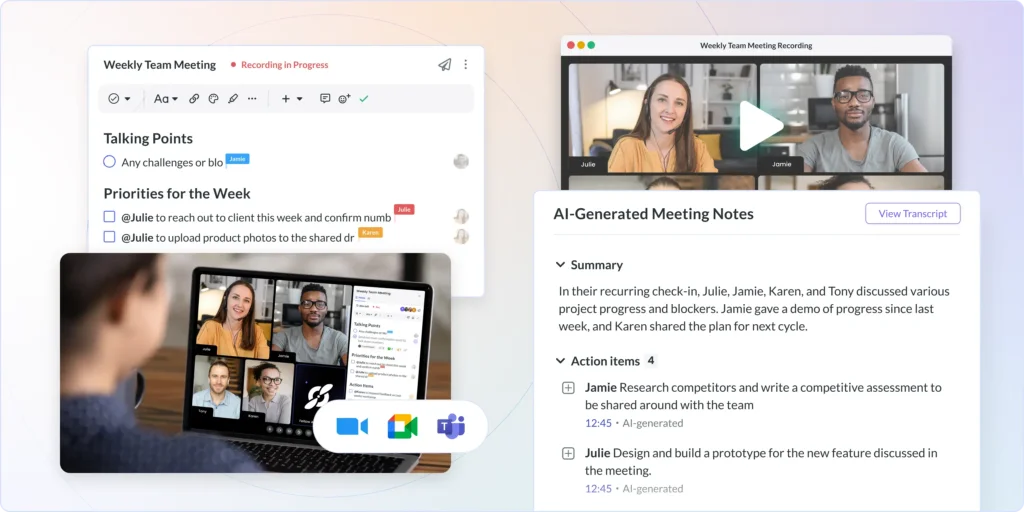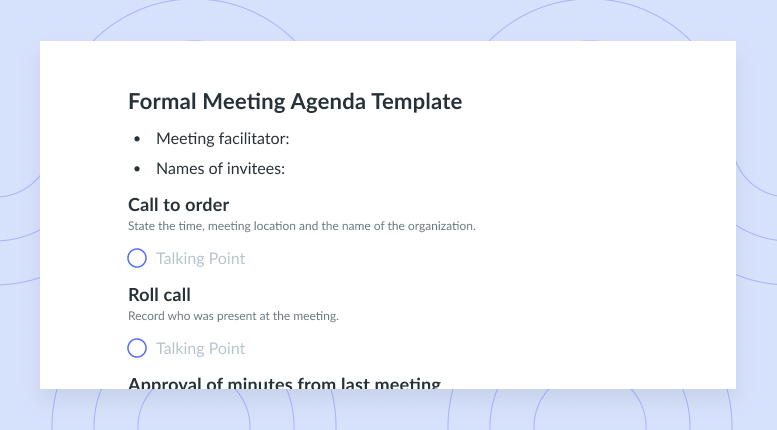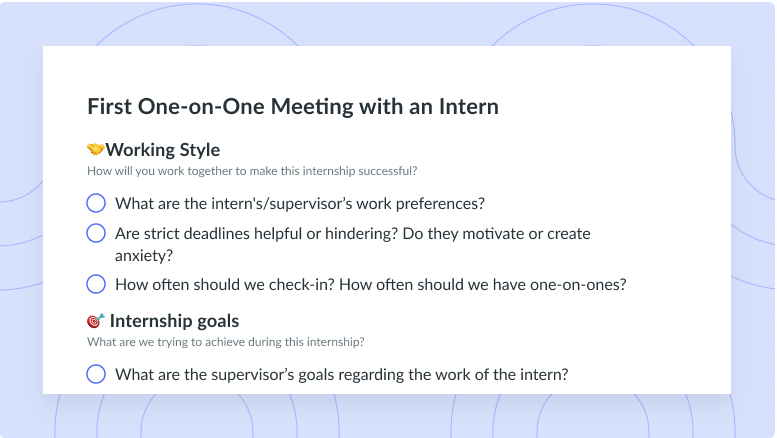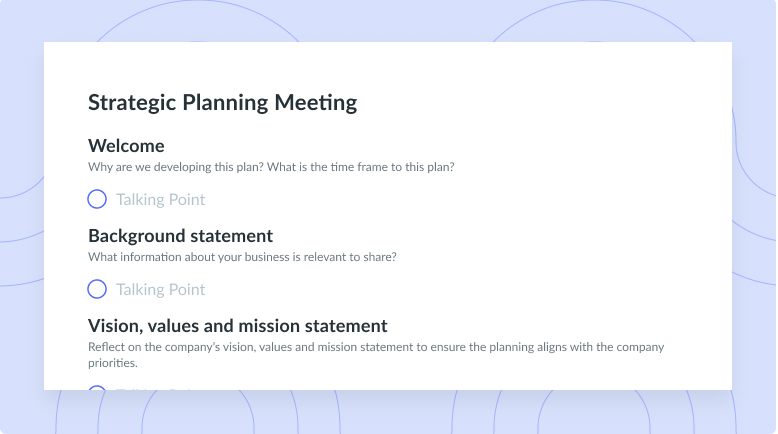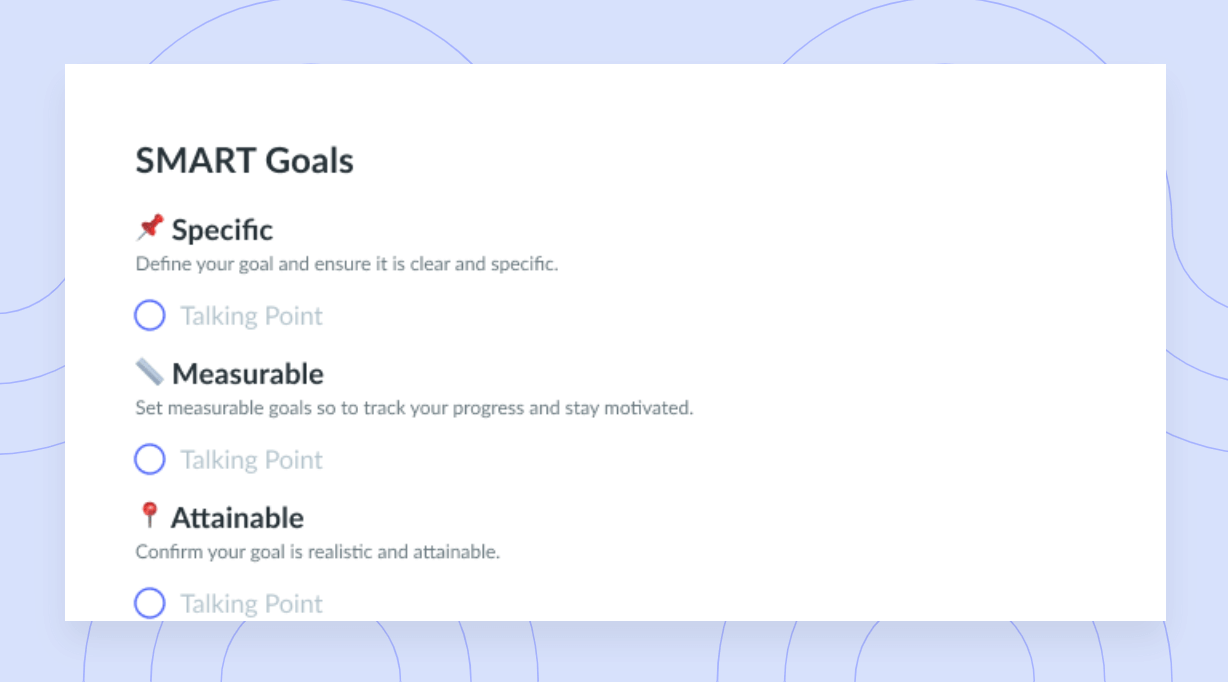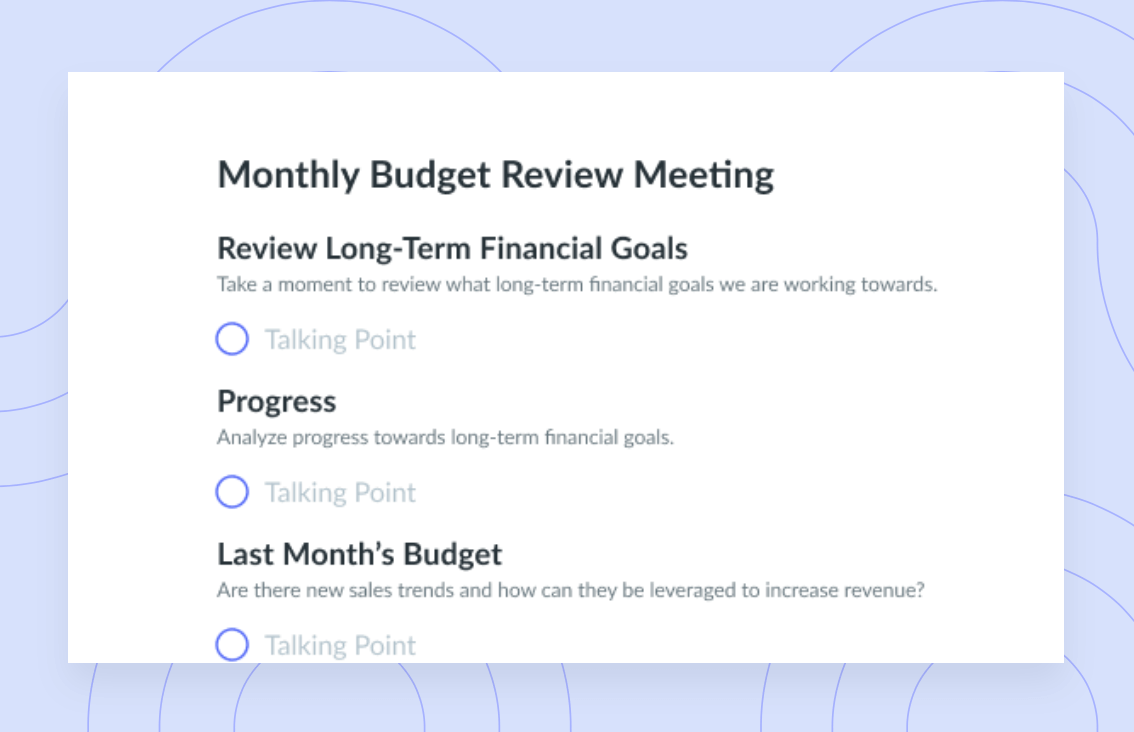Sprint Planning Meeting Agenda: Structure & Best Practices
Elevate your sprint planning meetings with this guide to creating effective agendas to drive success and collaboration.
Sprint planning meetings offer a swift means to align your teams efficiently, yet they often lack clear direction and cohesion. Creating a well-structured sprint planning meeting agenda is crucial for leaders who oversee project management or engineering teams. Without it, you risk miscommunication, wasted time, and inefficiencies. Read ahead to learn the must-knows for a successful sprint planning meeting agenda, empowering you to streamline your process and maximize your team’s productivity.
- What is a sprint planning meeting?
- Who attends a sprint planning meeting?
- What are the elements of a sprint planning agenda?
- How to prepare for sprint planning
- Looking back, moving forward with Fellow
What is a sprint planning meeting?
Picture a sprint planning meeting as a collaborative brainstorming session — an important part of the Scrum meetings framework. Here, the Scrum team works together to decide the achievable workload for the upcoming sprint and strategizes how to tackle it. This session sets the tone for effective project execution, providing a roadmap for team activities and ensuring everyone’s on the same page.
Sprints are defined periods for work, usually lasting from one to several weeks. Two-week sprints are common. During sprint planning, teams create structure, set expectations, and organize the backlog, preparing for an effective sprint ahead. Utilizing a sprint planning meeting agenda template can further streamline this process, helping ensure that all necessary steps are covered.

Elevate your sprint planning meetings with
Fellow’s AI agenda builder
Streamline your sprint planning agenda creation process with Fellow, the only all-in-one AI meeting transcription and management software for remote and hybrid teams. Fellow takes cues from your meeting title, previous meeting notes, and attendees to help build thoughtful, relevant meeting structures with topics and talking points for collaborators, saving you time and resources.
Who attends a sprint planning meeting?
There are three key players in a sprint planning meeting: the product owner, the Scrum master, and the development team. Together, they form the backbone of sprint planning meetings, driving collaboration, innovation, and success.
- Product owner: Think of the product owner as a liaison between the business realm and the development frontier. Charged with maximizing the product’s value, they represent stakeholders and manage the product backlog, ensuring alignment between business goals and development efforts.
- Scrum master: The scrum master’s mission is to foster effectiveness throughout the scrum process. They champion Scrum principles and coach team members and even the broader organization in the art of Scrum. Their presence ensures that the Scrum process flows seamlessly, empowering the team to reach its full potential.
- Development team: This talented team comprises cross-functional individuals, ranging from engineers to designers to programmers. They’re tasked with executing the plan and bringing the project to life, delivering value with every sprint.
What are the elements of a sprint planning agenda?
Here’s a breakdown of the essentials to include in your agenda for sprint planning meetings.
- Sprint goal: Kick off with a clear statement outlining what the team aims to achieve during the sprint planning. Make it concise yet impactful as a guiding beacon throughout the sprint.
- Story points: Use story points to gauge how much effort tasks in the sprint might need. These points help everyone understand how complex things are, any risks involved, and the overall size of the project. It’s all about keeping expectations realistic and manageable.
- Velocity: Check your team’s speed by checking their performance in past sprints. Knowing how much your team can accomplish in a sprint helps you set achievable goals and gives a good idea of how productive your team will be in the future.
- Capacity: Determine your team’s workload capacity by considering the sprint’s length, who’s available, and team members’ other commitments. This understanding helps you plan realistically and allocate resources effectively.
- Product backlog: Take some time to go over the backlog and decide which items are most important. Look at things like risks, what functions are needed, and any ways you can make things better. Make sure the items in the backlog aren’t too big so you can get them done successfully in the sprint timeframe.
- Considerations: Identify and discuss any extra details or possible risks affecting how well the sprint goes. This helps the team stay on the same page and work together to solve any problems before they become big issues.
How to prepare for sprint planning
Here is how to best prepare for sprint planning in agile.
- Conduct backlog preparation
- Check team availability
- Determine team velocity
- Organize your sprint planning meeting
1Conduct backlog preparation
Before sprint planning, the product owner must ensure the product backlog is in top shape. This means keeping it updated, organized, and aligned with the project’s goals. Regular refinements of the backlog, such as reordering tasks and updating estimates, are crucial for maintaining relevance and effectiveness. By investing effort in this process, the product owner sets the stage for a successful sprint, providing the team with a clear roadmap of tasks.
2Check team availability
As you gear up for the upcoming sprint, have open and honest conversations with your team. Understand any potential constraints or competing commitments that may detract from the sprint. This includes discussing planned time off, such as vacations or personal days, and any obligations to other projects or teams. By taking the time to assess and adjust the workload accordingly, you not only maximize productivity but also foster a culture of trust within the team.
3Determine team velocity
Understanding your team’s velocity is key to setting realistic expectations for the upcoming sprint. By analyzing past sprint performances, you gain valuable insights into your team’s working pace, efficiency, and capacity for delivery. Factors such as experience levels, skill sets, and the readiness of the backlog all play a crucial role in shaping this velocity. With this knowledge, you can confidently set goals that stretch the team just enough to drive growth without overwhelming them.
4Organize your sprint planning meeting
The sprint planning meeting is a critical event in the agile process, and careful organization is essential for its success. As the Scrum master, take the lead in planning the logistics of the meeting, including scheduling, attendee selection, and agenda creation. Make sure to share the agenda in advance. Leverage one of Fellow’s expert-approved meeting templates for sprint planning like the ones below so everyone makes the most of the meeting time.

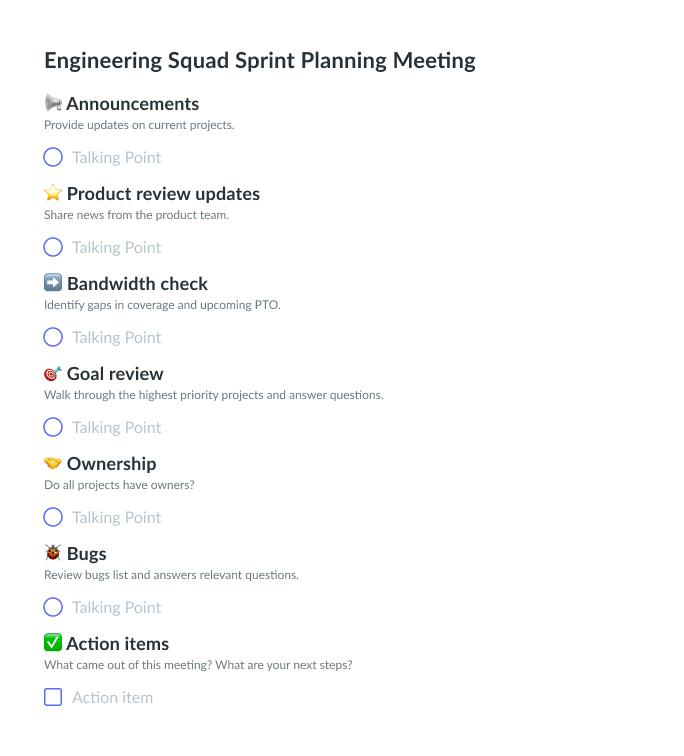
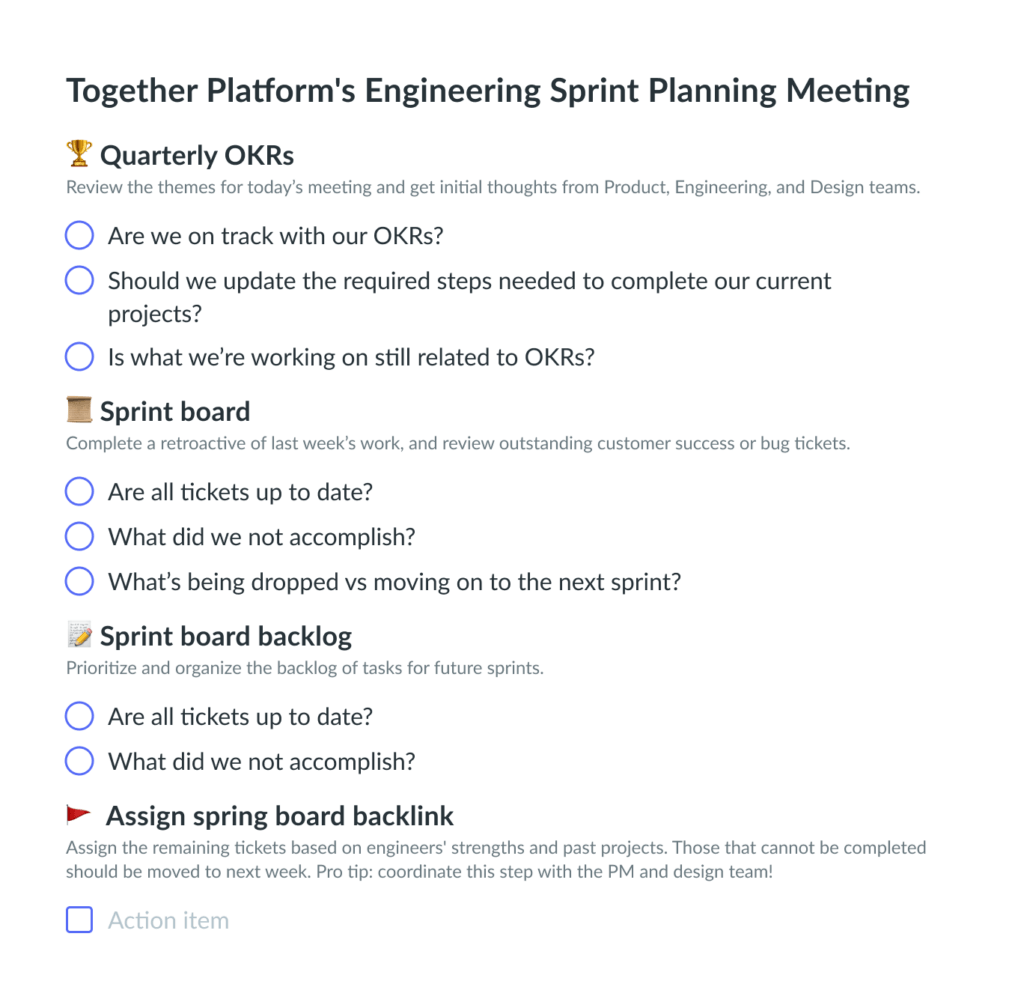
5 best practices for a sprint planning meeting
Follow these 5 best practices to run a successful sprint planning meeting.
- Prepare in advance
- Be concise
- Allocate time for addressing possible concerns
- Focus on the sprint’s objective
- Document your meetings
1Prepare in advance
Thorough preparation sets the tone for a successful sprint planning meeting. It’s about more than just showing up—you want everyone on the same page and ready to dive in. This includes reviewing the backlog, clarifying sprint goals, and identifying any potential tasks or dependencies upfront. Arriving well-prepared creates an environment for productive discussions and effective decision-making. With everyone aligned and informed, you can make the most of your time together and set a solid foundation for the sprint ahead.
2Be concise
During sprint planning meetings, time is of the essence. That’s why keeping discussions focused and to the point is essential. Your team can maximize your time together by sticking to the agenda and prioritizing key topics. Encouraging brevity and clarity in communication helps maximize efficiency and keep the meeting moving smoothly.
With everyone on the same page and distractions minimized, you can tackle objectives effectively and efficiently. This streamlined approach not only promotes timely decision-making but also fosters a sense of respect for everyone’s time and contributions.
3Allocate time for addressing possible concerns
In any sprint planning meeting, it’s crucial to anticipate and address potential concerns or challenges. By setting aside a dedicated time to discuss these issues, you provide a space for team members to voice their thoughts and collaborate on solutions.
This proactive approach not only helps alleviate risks but also gives everyone a chance to feel heard and valued. With open communication and a focus on problem-solving, you can address any obstacles head-on and set your team up for success.
4Focus on the sprint’s objective
Throughout the sprint planning meeting, it’s important to keep your eyes on the prize: the sprint’s objective. Every discussion and decision should be aligned with this overarching goal. Maintaining this focus promotes alignment and clarity among team members, driving progress and accountability. With a shared understanding of what you’re working towards, you can make informed decisions and keep your team’s efforts moving in the right direction. This cohesive vision does more than enhance productivity — it also fosters a sense of camaraderie and purpose within the team, as everyone works together toward a common goal.
5Document your meetings
Effective documentation is the backbone of any productive sprint planning meeting. By keeping detailed meeting notes, including agreed-upon tasks, timelines, and responsibilities, you can help every team member stay on the same page. Sharing these notes with relevant stakeholders promotes transparency, keeping everyone informed and accountable for their actions.
Also, consider recording the meeting or using AI meeting notes tools like Fellow to keep everyone on the same page. This way, you can capture discussions and track important insights and decisions. It’s a seamless way to ensure nothing valuable gets lost in the shuffle.
Looking back, moving forward with Fellow
As you navigate your agile journey, emphasize the values of collaboration, focus, and thorough documentation.
Fellow empowers teams to achieve agile excellence seamlessly, from structured agendas to robust documentation features centralized in one place. Whether orchestrating your next sprint session or gearing up for a sprint retrospective, Fellow’s sprint templates help team members updated on the upcoming sprint’s objectives, tasks, and priorities.
Post-meeting, Fellow’s action items feature allows project managers or leaders to allocate tasks and resources to the right people, ensuring a successful sprint. It can also automatically send reminders and notifications to assigned team members, keeping them accountable for their action items. This eliminates the need for manual follow-ups and helps ensure that tasks are completed on time.
With advanced AI features, Fellow records, transcribes, and summarizes your meetings while seamlessly integrating into your meeting workflow and favorite PM tools. It captures an accurate record of the discussion so everyone stays aligned and even automatically identifies meeting outcomes and action items based on the conversation.
Take the next step towards more effective sprint planning and collaboration with Fellow!
